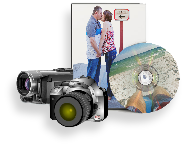Baby’s first steps, the first day of school, or a 50th wedding anniversary — you’ve probably captured many memories with your camcorder. What will you do with all that footage? Will you play it back on your TV? Will you make copies to share with friends and family? Will you edit your files and archive them to enjoy for years to come? Below, we’ll look at what you can do with your camcorder footage and offer our suggestions and tips for getting the best results with your home movies.
Today, we are using an article that was posted on crutchfield.com. This was a very informative article on how to play and archive your camcorder videos. We give all credit to the author, Tara W. at Crutchfield for all of the hard work. The article was a little dated so we went through and got the information more up-to-date.
Playing your videos on a TV

Watching your footage on a TV is simple enough — simply connect the camcorder to your TV with the audio/video cables that come in the box. Most camcorders come with a composite video cable, but if you have a high-def camcorder and want to use its component video or HDMI connection, then you’ll probably need to purchase these cables separately. And if you go with an HDMI connection, you won’t have to make a separate audio connection to you TV, since HDMI can pass both video and audio signals.
Watching your videos on a computer
Most camcorders transfer video files and photos onto your computer via a USB interface. Most newer computers have high-speed USB ports, but if you’re using an older computer then you may have a full-speed USB port, which just means that your video transfer might take a little longer. If you have an older mini DV or Digital8® camcorder, you’ll probably need an i.LINK® (IEEE 1394) jack to transfer digital video from the cam to your computer. If you have a newer computer without an i.LINK jack, it should be fairly easy and inexpensive to add one via an optional PCI or PC card.

Mini DV camcorders use i.Link jacks (left) to transfer videos to a computer, while hard drive and mini DVD camcorders use USB ports (right). |
New ways to share and enjoy your videos
With recent technology advances, it’s become easier than ever to copy and share footage for all to see. Here are a few new ways to share your home movies:
- Post your videos on a website. Video-sharing sites like YouTube™ and video blogs make it easy to post footage that your friends and family can view. Post clips of baby’s first steps, your child’s birthday, or that crazy family reunion you went to last year. You can use special software to compress your recordings for posting on these sites, or invest in a web-friendly cam that produces videos that are easy to upload to sites or e-mail directly to family.
- Store footage on an iPod®, iPhone®, or MP3 player. Transfer video clips to your portable player and show them off to family members next time you get together at the holidays. Putting videos on a portable player may also require special software that converts your videos to a compatible format. Some players can be connected to a TV for large-scale playback of your videos.
- Use the SD card slot or USB port on your HDTV. Some newer HDTVs offer built-in SD memory card slots and USB ports. That means that if you have an SD memory card camcorder, you can copy footage onto the SD card and pop it into the card slot on a compatible HDTV. And of course you can connect just about any camcorder with a USB port up to a compatible HDTV. Just be sure to check your television’s manual to be sure that it’ll play back video, and that it’s compatible with your camcorder’s video recording format. A lot of newer Blu-ray players, game consoles, and receivers also offer SD card slots or USB inputs, in case your TV doesn’t have one.
- Stream your videos to your TV. If you have your videos stored on your computer, then it’s easy to stream them to your TV or other compatible home theater gear. You won’t need any cables to connect your camcorder to your TV, and will have your whole library of videos on your computer at your finger tips.
Copying and archiving your footage for yourself and others
It’s unfortunate, but discs and tapes can break, wear out, or get lost, and hard drives fail eventually. So we recommend that you make multiple copies of your videos. You can use a number of different devices to make copies of your footage — from DVD recorders to your computer (if it has a DVD burner).
DVD recorders for camcorders are designed specifically to help people archive their camcorder footage. They’re especially handy for folks who have a hard drive camcorder but don’t have a computer with a DVD burner. You’ll probably use the USB output on your camcorder to make a digital connection to these DVD recorders. Then, you can record your footage on full-size DVD discs for playback in most DVD or Blu-ray players.
Some DVD recorders may only offer standard-definition recording. Others will allow you to copy standard- and high-definition video footage — a big plus for HD camcorder owners. You’ll be able to downconvert your high-definition (HD) videos for playback on most DVD players, or maintain the high resolution of HD video files for playback on the recorder itself or a compatible Blu-ray Disc™ player.
Another archival option: use your PC and an external hard drive.
If you have a PC, you can attach an external hard drive to your computer and simply copy footage from your tapes and discs onto the hard drive. Saving files onto an additional hard drive lets you keep your computer’s internal one free for everyday needs. Finally, if you fill up an external hard drive with your home movies, you can unplug it and keep it somewhere safe, and connect a new one for your next batch of archives. It might not be a bad idea to make a regular schedule to copy your irreplaceable footage to archive drives on a regular basis and duplicate those. Then house those duplicate drives in a nice, climate controlled place that’s not your home. That way you’re covered for most mishaps, whether the cause is human, natural or mechanical.
Online storage, while a great idea for documents and pictures, can easily be overwhelmed by the sheer data space requirements of video archiving. Aside from the fact that video takes up a lot of storage space, the time you’d need to devote to uploading and downloading material would probably be measured in days over many internet connections. If you want to save a few important, selected clips, it’s not the worst place to do so, but remember to check out the storage site’s guidelines on file size limits, and check those monthly or annual costs carefully. It’s also a good idea to read some customer reviews, if you can.
Relive Your Memories! You Shoot It – We Edit!

Now, don’t let these precious moments stay stored on hard drives, memory cards, or tapes for months, years, and sometimes, even forgotten forever. Memories are like diamonds, and happy memories are like those rare diamonds that always remind us of our happy days and keep our hope for a better life ahead. These precious memories are worth preserving. Casually Sharp Multimedia is the perfect place to bring out the best in your photos and videos. We can be as creative as you want and need. Give us an opportunity to help carve your memories in the shape of videos! Relive your memories! You shoot it – we edit! Services. Pricing.
